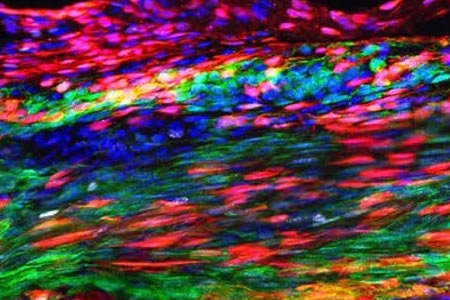Image source: Tyler Harvey, Carnegie Institution of Sciences.
There is often a long road to recovery when a tendon is injured, during which time patients may continue to experience considerable pain and a full recovery may not be possible.
Tendons connect muscle to bone and form anchor points that allow the muscles to work and move the bones. As with muscles, tendons are prone to injury due to excessive force. The healing process is often slow and often sees the formation of scar tissue. Oftentimes a full recovery is not possible due to the buildup of scar tissue. The scar tissue can also lead to secondary tendon ruptures, further delaying recovery. In many cases, surgery is required.
The fact that tendons never fully heal suggests that there are no tendon stem cells. Researchers have searched for these elusive tendon stem cells but they have never been found. Until now. A team of researchers at the Carnegie Institution of Sciences led by Chen-Min Fan has discovered previously undefined tendon stem cells in the Patellar tendon, located under the kneecap.
The researchers categorized all cell types in the Patellar tendon and identified a population of stem cells. Stem cells have the ability to form into all cell types in the body and can self-renew almost indefinitely. Stem cells are present in all tissues and help with the healing process.
The researchers found the stem cells in the same location as the cells that form fibrous scars in the tendons – The protective surface layers of the tendons. The researchers showed that during the healing process, both types of cells are in competition.
The researchers demonstrated that in response to injury to a tendon, the platelets in the blood release platelet-derived growth factor A. This protein stimulates the repair of the tendon. The scar tissue precursor cells and the tendon stem cells are stimulated. If the tendon stem cells stop responding to platelet-derived growth factor A, a scar forms that is predominantly fibrous and new tendon cells are not formed.
If the stem cells could be harnessed, full recovery from injury may be possible without the need for surgery. That could be achieved by stimulating the tendon stem cells to get them to respond quickly and more intensely than the scar precursor cells. Alternatively, it may be possible to inhibit the scar precursor cells to give the tendon stem cells time to differentiate into mature tendon cells. The result should be the formation of healthy tendon cells with little to no scaring.
The study is detailed in the paper – A Tppp3 Pdgfra tendon stem cell population contributes to regeneration and reveals a shared role for PDGF signalling in regeneration and fibrosis – which was recently published in the journal Nature Cell Biology. DOI: 10.1038/s41556-019-0417-z
